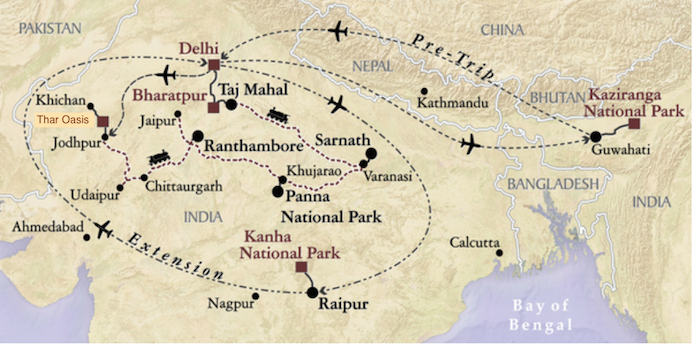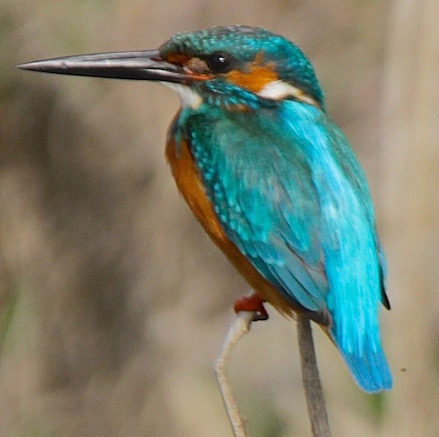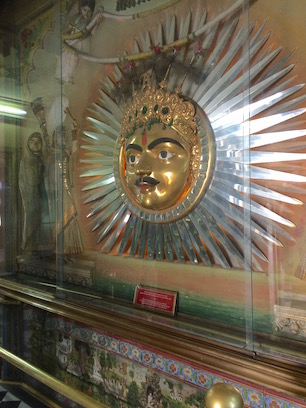
Today our train took us from Jodhpur to Udaipur and then on to Chittaurgarh
(Image courtesy of VENT)
(Click on images to enlarge)

|
It was clear this morning that Lee has a really bad cold, but he soldiered on.
By the time we’d all finished breakfast, our train had pulled into the
station in Udaipur, so we set out right away to see as much as we could of this
amazing city.
I was much struck by the terracotta frieze on the front of the Udaipur railway station. It shows trains mixed with mythological scenes and has a string of dancing figures that appear to have been taken from petroglyphs. I later learned that it is the work of Dinesh Chandra Kumhar, a 15th-generation potter from a family who have traditionally made Hindu devotional plaques. They live in a small potters village 50 kilometers north of Udaipur.  Dinesh Chandra Kumhar I wish I knew where to buy one of his Ganesha plaques. |
Facade of Udaipur railway station |
|
Chetak |
Once in our bus, we were introduced to our excellent young cultural guide for
the day. As we drove and drove through this “small” (for India)
city, he spoke eagerly on many topics and seemed to long for questions.
When we passed this sculpture of a white horse, our guide explained that it honored Chetak, the favorite war horse of Maharana Pratap. In a battle against Emperor Akbar in 1576, Chetak was injured by a Mughal elephant that had been trained to hold a sword in its trunk and swing it at the opposing horses. Though badly wounded, Chetak managed to carry his master away from danger before dying. (The Hindus retaliated against the Mughal’s war elephants by putting elephant masks with trunks on their horses to make them appear to be baby elephants.) |
| Udaipur is a really beautiful city built around artificial lakes with mountains nearby. The Monsoon Palace, an elegant white building, looks down from the nearest mountainside. (There are also Winter and Summer Palaces, the latter on an island.) |
|
Monsoon Palace, Udaipur |
Summer Palace, Udaipur (now the Lake Palace Hotel) |
| Really nearby, we had our first Common Kingfisher of the trip. It perched in some debris for long enough to get itself thoroughly photographed. And we got a great look at an Indian Pond Heron. |
 Common Kingfisher (Image courtesy of Amy Sheldon) |
 Indian Pond Heron (Image courtesy of Amy Sheldon) |
| Another spot further on was even better; I got three lifebirds in three minutes (and missed another—I tend to panic when confronted with a bunch of different birds at the same time). On a tiny spit of land were two Great Thick-knees, some River Terns, two Asian Openbills (named for the gap between their mandibles), some Small Pratincoles, and a Temminck’s Stint. On a wire above us were two Wire-tailed Swallows; we could just make out the tiny “wires” extending beyond the tail. Pattering around near the shore were four kinds of Wagtail, but I failed to get onto the Citrine (which was obviously in plain sight if Amy could get such a nice photo—sigh). |
|
Great Thick-knee |
Asian Openbills |
|
Wire-tailed Swallows |
 Citrine Wagtail (Image courtesy of Amy Sheldon) |
|
Lake Pichola, Udaipur |
Lake Pichola, Udaipur |
| We stopped on an island at what was once the royal guest house, Jag Mandir, and were greeted by sculptures of elephants. The stop gave us a chance to have tea and cookies seated at a table overlooking the lake and to enjoy the blue-and-white decor with more elephants. |
|
Jag Mandir (the Lake Garden Palace), Udaipur |
Tea at Jag Mandir, Udaipur |

| Once we were done with our tea, we hailed another boat to take us back across the lake for a tour of the City Palace (the Winter Palace), actually a series of structures, some dating back as far as the mid-16th Century. (It was begun by Maharana Udai Singh II in the year 1559 and has been added to since then by his 76 successors as Maharana.) It exhibits a fusion of Mughal and Rajasthani architectural styles (along with touches of Chinese and European). |
|
City Palace, Udaipur |
Palace entrance |
| As we passed through an ornate gate into a courtyard, we found wall paintings that we were told had been redone a few years ago to celebrate the wedding of the prince. The Maharanas are considered to be descendants of the Sun god, so the symbol of a mustached Sun appears everywhere in the palace, such as on this elephant’s covering (and even on the lift doors). |
|
Wall painting in City Palace, Udaipur |
 Sun god symbol |
| As in our earlier visits to palaces in Rajasthan, my strongest impression was of the wonderfully intricate stone carving. |
|
City Palace, Udaipur |
City Palace, Udaipur |
| The palace also has a good collection of paintings from the height of the Mewar court. I loved this one that showed the adjacent roof-top garden: |
|
Mewar painting, City Palace, Udaipur |
Roof-top garden, City Palace, Udaipur |
| Among the remarkable sights were some exquisite carved ivory doors. And we enjoyed the views out over the city. |
|
Carved ivory doors, City Palace, Udaipur |
View from the roof of City Palace, Udaipur |
|
Mor Chowk (Patio of the Peacocks) |
Detail of one of the peacock mosaics |
|
Downstairs from the Crystal Gallery was an elegant dining room, the Durbar
Hall, where we were served an excellent lunch starting with a mushroom-almond
soup that was especially good. I also really enjoyed the desert of home-made
vanilla ice cream and a tiny clove-and-aniseed pastry. By the time the meal
was over, we were running late, but fortunately it was not a long drive to the
train station. We left Udaipur feeling that there was much more we might have
seen if we’d been there a bit longer.
Wherever we drive in India, through cities or towns or villages, we see arrays of luscious-looking fresh produce spread out for sale. One orange vendor we passed today had decorated his pyramids of oranges with red-purple Bougainvillea blossoms, a very pretty touch that seemed to shout “India” to me. The plan was to continue on the train for a couple of hours to Chittaurgarh and then stop for more sight-seeing, including Chittaurgarh’s massive fort: |
 Chittaurgarh Fort (Image courtesy of Wikimedia Commons) |
 Vijay Stambha, Chittaurgarh (Image courtesy of Wikimedia Commons) |
|
But the train was running so late that it seemed likely there wouldn’t be
time in Chittaurgarh for much other than the light and sound show at the fort.
Lee was clearly dragging, and we decided some years ago that we have already
seen all the light and sound shows we are required to see in our lives. So, we
disappeared into our cabin for what remained of the day. We napped and then had
the luxury of showering while the train wasn’t moving. Keith solicitously
brought us hot tea, and we dined on our stash of granola bars.
My birds for the day: |
| Lesser Whistling Duck | Gadwall | Eurasian Wigeon | Indian Spot-billed Duck | Garganey |
| Green-winged Teal | Common Pochard | Tufted Duck | Indian Peafowl | Little Grebe |
| Asian Openbill | Indian Cormorant | Great Cormorant | Little Cormorant | Grey Heron |
| Eastern Great Egret | Intermediate Egret | Little Egret | Glossy Ibis | Black-headed Ibis |
| Shikra | Black Kite | Common Moorhen | Eurasian Coot | Great Thick-knee |
| Black-winged Stilt | Red-wattled Lapwing | Little Ringed Plover | Pheasant-tailed Jacana | Green Sandpiper |
| Black-tailed Godwit | Temminck’s Stint | Small Pratincole | River Tern | Rock Pigeon |
| Eurasian Collared Dove | Common Kingfisher | White-throated Kingfisher | Indian Grey Hornbill | Rose-ringed Parakeet |
| Black Drongo | House Crow | Dusky Crag Martin | Wire-tailed Swallow | Red-rumped Swallow |
| Common Chiffchaff | Western Yellow Wagtail | Grey Wagtail | White Wagtail | House Sparrow |

